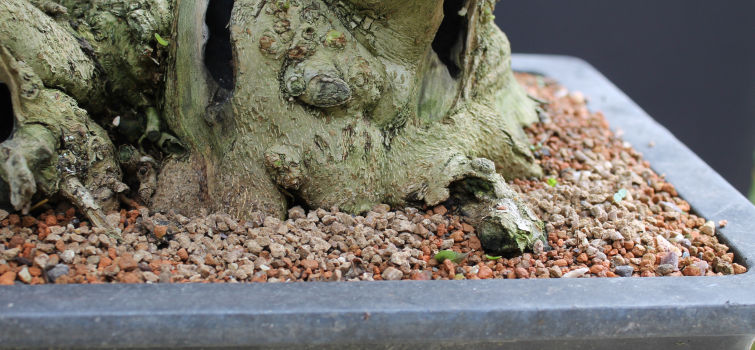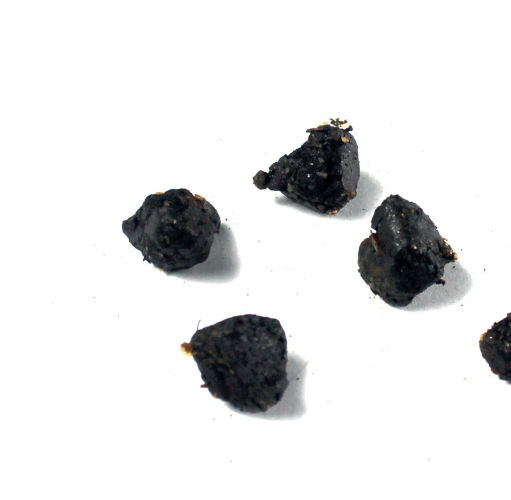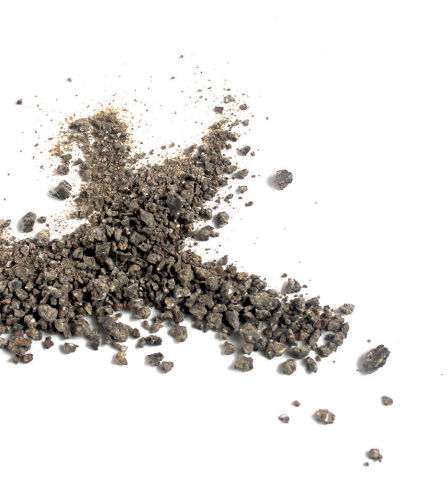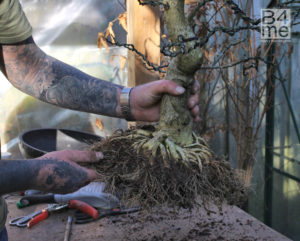Although Bonsai are repeatedly pruned throughout their lives to keep their small stature; they are never deprived of nutrients to stop them growing. A tree planted in the ground is able to extend its root system in search of nutrients, however, a tree planted in a bonsai pot is unable to do so. After a relatively short period of time the soil in a bonsai pot loses its nutritional content as it is harnessed by the tree. Much nutrition is also lost from the effects of watering as it is literally flushed out of the soil. For a bonsai tree to continue to grow vigorously, the soil it grows in must have its nutritional content repeatedly replenished.
Plant Nutrients
In order to grow, trees use carbon, hydrogen and oxygen from the air, and water from the soil to manufacture their own starch and sugars. They also need from the soil a number of simple chemicals which they use to create amino acids, proteins, vitamins and enzymes.
All organic soils have a stock of these vital chemicals; they come from the mineral part of the soil (sands/clays/grit) and from dead organic matter (fallen leaves and dead plant matter).
However, in the confines of a bonsai pot these vital elements are soon lost from organic soils, and with the increased use of inorganic soils in modern bonsai, can be seriously lacking in one or more of these elements.
The most serious loss concerns three elements; nitrogen, phosphorous and potassium. These are known as the major plant nutrients and are required in relatively large amounts if plants are to grow well. There are a further number of ‘trace elements’ that are required to be present in the soil, but only in small quantities.
Nitrogen (N) is primarily used by plants for leaf growth, Phosphorous in the form of phosphates (P2O5) is primarily used by plants for root-growth, Potassium in the form of Potash (K20) for flower and fruit production.

Slow-release fertiliser pellets on the soil surface of a bonsai.
Fertilisers
To supply your bonsai with a continual supply of essential plant nutrients it is necessary to regularly apply fertiliser. There is NO need to purchase ‘bonsai feed’ or any other ‘special’ bonsai fertiliser. Essentially ordinary plants, bonsai are more than able to cope with ordinary soluble garden fertilisers. It is far more important that a fertiliser with the correct nutritional balance is chosen.
By law, the manufacturer of a product described as a fertiliser must declare the nitrogen, phosphates and potash content on the package. The content of most other nutrients must also be declared if they have been added to the product. When purchasing a fertiliser, look for the NPK rating on the packaging.
The first figure refers to the percentage of Nitrogen (N), the second to the percentage of phosphates (P2O5) and the third to the percentage of potash (K20).
It is important when purchasing fertilisers for the majority of bonsai that the three major elements are balanced. However it is possible to control the type of growth a plant makes by applying different fertilisers, many fertilisers available to the enthusiast are suitable; for instance to encourage flower production in bonsai, a fertiliser containing a higher proportion of Potash could be used.
When purchasing fertiliser for bonsai, ensure that all three elements are balanced and are listed as being equal (for instance 10:10:10 or 15:15:15). My personal preference when purchasing fertilisers is the Chempak series which are widely available at garden centres and DIY stores throughout the UK and America.
Applying Fertilisers
Soluble fertilisers are mixed with water and are applied to the whole of the soil surface until no more can be absorbed and surplus fertiliser runs out of the drainage holes of the pot.
It should be understood that a fertiliser with an NPK of 10:10:10 is the same as a fertiliser with an NPK of 20:20:20. It is not half as strong if mixed to the manufacturers recommended dose, but it does require twice as much fertiliser to be used to reach the recommended dosage strength. Fertilisers are produced to promote optimum levels of growth in a plant and the manufacturers recommended dosage should be followed to achieve the best NPK level available for your bonsai.
Fertiliser should ordinarily be applied every other week to a bonsai, or as indicated on the packaging. Do not bother to feed at ‘half strength’ as is often advised by bonsai texts, this is unnecessary.
High and Low Nitrogen Fertilisers
The essential fertiliser for bonsai is one that is balanced ; that is to say has equal balance of Nitrogen, Phosphorous and Potassium. There are two other combinations that are useful (though not absolutely essential) to successful bonsai feeding, these should be applied as an alternative to a balanced feed NOT as an additional feed.
A fertiliser high in Nitrogen (for instance 25:15:15) is often applied to many species (particularly when in training) during the spring, the higher proportion of Nitrogen encourages stronger leaf and shoot growth. It should not however be fed throughout the growing season as this would eventually result in too lush green growth with long internodes.
A fertiliser low in Nitrogen is very useful when applied to bonsai from late-summer through to dormancy. The relatively high Phosphorous and Potassium content helps to strengthen the years growth and the root system before the cold of winter. It also increases bud production for the following year. Top growth that would otherwise succumb to the first frosts in autumn is slowed. Ultimately a fertiliser that is rated as 0:10:10 and contains no nitrogen is preferred but can be hard to obtain and is relatively expensive. A suitable alternative is to use a low-nitrogen fertiliser (12.5:25:25) that is diluted by half.
Fertilising Lime-Hating/Ericaceous Plants
Lime-hating plants such as Enkianthus, Azaleas (Rhododendrons) and Stewartia require regular replacement feeds of specially formulated fertilisers which ensure that their soil pH remains acidic, and ericaceous fertilisers also contain higher levels of chelated iron which is required by lime-hating species to offset chlorosis.
Many Pine species and Juniper species also benefit from monthly ‘acid’ feeds.
Suitable fertilisers include Miracid or any other fertiliser that is indicated as being specifically for ericaceous or lime-hating plants.

Solid, slow-release fertiliser cakes.
Solid Fertilisers
Japanese bonsai growers traditionally used solid fertilisers such as small cakes of fish-meal or rape-seed that are placed on top of the surface of the soil, slowly releasing nutrients every time the tree is watered. The primary advantage of solid fertilisers is that they continually supply the tree with small amounts of nutrients and only require replacing every two to three months so they are less time-consuming to apply.
There are now several solid/slow-release fertilizer-brands on the market i.e. Green Dream and Biosorb, both of which are excellent for outdoor bonsai (they tend to leave an odour which makes their use indoors less attractive!)

Green Dream s low-release fertiliser that is spread across the surface of soil and is dispersed into the soil itself after watering.
Overfeeding
If the nitrogen content of the bonsai soil becomes too high it will burn the roots. Always follow the mixing and application rates described on the fertiliser packaging, never mix a higher concentration than is described and do not feed more frequently than is advised. Overfeeding can result in less growth NOT more.
Trees that are dormant or sick should not be fed as they will not consume the same level of Nitrogen and if care is not taken, salt levels in the soil can build up.
It is often recommended that newly repotted trees should not be fed for at least six weeks to avoid burning new roots.
However, there is now much anecdotal advice and some scientific evidence that promotes the advantages of feeding straight after root-pruning and repotting. Immediately after root pruning, a plant will require additional nutrients to grow and repair roots, particularly phosphorous and potassium. A low nitrogen feed would be very beneficial to the plant and unlikely to burn the roots.
Do’s and Don’ts of Fertilising
Do use fertilisers regularly; they are essential to the health of your bonsai and produce strong, vigorous growth.
Do check the requirements of individual species; different species can require different quantities of fertiliser at different times of the year.
Don’t feed trees when they are not in active growth as the unused fertiliser level builds up in the compost, potentially resulting in an excessive build up of salts.
Don’t feed trees that are not growing due to poor health for the same reason; feeding a sick tree is unlikely to encourage it to grow and will do more harm than good.




